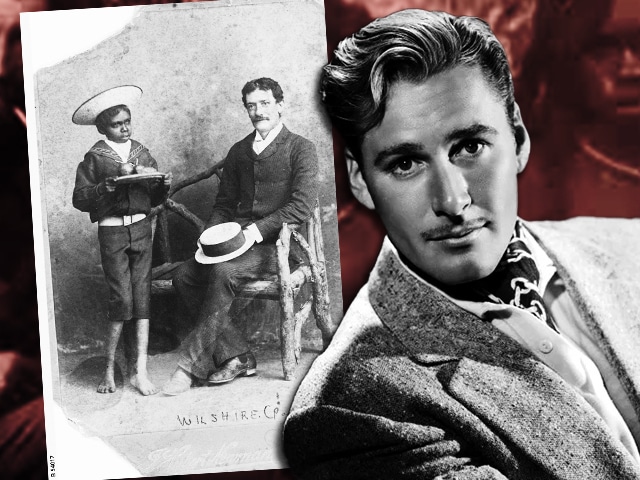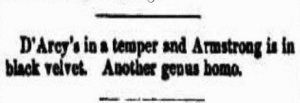This is the first of two pieces to be published by Dr Robyn Smith that draw on her research of massacres and the enslavement of women in the Northern Territory.
During the late 1920s, an Australian man travelled to Sydney from Papua New Guinea for ‘black pox’ treatment after a sexual ‘relationship’ with a child he described as “like a little puppy” notwithstanding his “horrible feeling of guilt” about repeatedly raping her. His guilt was, as Patricia O’Brien wrote, about her race, not her age nor his predatory criminal behaviour.
By the early 1930s, he was back in New Guinea — presumably cured of gonorrhoea — swanning around as manager of a tobacco plantation and leaving a trail of debts in his wake.
On this occasion he bought a “downcast-eyed little woman or girl” for two pigs, a couple of shillings and some seashells.
Once again, he held her as his sexual slave.
That man was international heart-throb Errol Flynn.
Flynn was not unique and, in fact, was representative of white colonial men the world over.
Closer to home, the notorious Mounted Constable William Willshire devoted a great deal of his taxpayer-funded policing time in the Northern Territory to the rape and impregnation of Aboriginal women and girls in Central Australia and the Victoria River region.
In both places, he practiced his fetish with impunity; it was his propensity for murder that brought him undone.
Drovers, overlanders and pastoralists were possessed of a similar sense of entitlement: their abduction of women and the sexual slavery that followed was part and parcel of the process of frontier expansion.
Take, for example, William John ‘Nugget’ Morton who held Broadmeadows Station in Central Australia.
As Justin O’Brien wrote, a 1937 investigation into Morton’s behaviour by Patrol Officer TGH Strehlow and Alice Springs-based Sergeant Koop resulted in this notation by Strehlow.
“‘Nugget’ was…employing [women] as ‘stockmen’ (he has no male abos. working for him) one or two other little native girls, 9 or 10 years of age, whom he had raped. Another little girl he had given to his nephew ‘Shrimp’, who was about 17 years of age,” Patrol Officer Strehlow wrote.
“Ben Nicker, who was working for Nugget was similarly using a little girl, and both Ben and the girl were suffering from gonorrhoea.'”
A brute of a man, Morton was a neighbour of Coniston Station’s Randall Stafford and took part in the Coniston reprisals before himself being attacked and wounded at Tomahawk Waterhole in August 1928. The attack was said to be the result of his abduction and abuse of Aboriginal women.
Benjamin Esmond Nicker, who was killed in action in Greece during World War II, was the son of respected Central Australians Samuel Foreman and Elizabeth Nicker after whom several places in and around Alice Springs are named.
Abducted women were often disguised as men and, as Ted Egan wrote, were known as ‘the drover’s boy’ in his song of the same name.
In the Camooweal Pub they talked about,
The death of the drover’s boy,
They drank their rum with the stranger who’d come,
From the Kimberley run, Fitzroy,
And he told of the massacre in the west,
Barest details – guess the rest,
Shoot the bucks, grab a gin,
Cut her hair, break her in,
And call her a boy – the drover’s boy,
And call her a boy – the drover’s boy.
Young Will Coulthard, visiting nephew of the Willowie Pastoral Company’s William ‘Billy’ Coulthard, was referencing his uncle’s contemporary Alf Wallis in his 1902 diary entry.
“[We] used to leave the packhorses with a nigger and Gin Wallace [sic] has got with him. The gin is dressed up as a boy and looks fine. Sits a horse splendid,” Coulthard wrote.
Like most nefarious practices across the frontier, the fetishisation of Aboriginal women was universally known and veiled by a range of euphemisms, principal among them ‘black velvet’.
By way of example, the followings entry about the Pine Creek goldfields appeared in the NT Times and Gazette in 1881.
It references none other than Wentworth D’Arcy Uhr (more famous for his murderous Gulf country exploits with the Queensland Native Mounted Police) and his business partner Mitchell Dare Armstrong.
The phrase was so universally known, wrote Liz Connor, that Henry Lawson included it in his 1899 The Ballad of the Rouseabout.
I know the track from Spencer’s Gulf and north of Cooper’s Creek –
Where falls the half-caste to the strong, ‘black velvet’ to the weak –
(From gold-top Flossie in the Strand to half-caste and the gin –
If they had brains, poor animals! We’d teach them how to sin.)
This is but some of the truth of the frontier.
Not discussed is what happened in the event that a woman was able to escape. The pursuit, beatings, stock-whipping and inevitably violent sexual savagery that followed are so obscene as to have been almost obliterated from the sanitised narrative of the ‘settlement’ of Australia that we have been taught to embrace.
Our cities, towns, statues and electoral divisions bear the names of some of the worst offenders, but that detail, too, has been omitted from the sanitised records of conferral of high civic honour.
It is long past the time for a rethink.
Dr Robyn Smith is the author of Licence to Kill: massacre men of Australia’s north, which will be launched by Professor Reuben Bolt at Charles Darwin University on June 18, 2024 and will feature at the NT Writer’s Festival on Sunday June 30. It is the culmination of Dr Smith’s years of research on colonial frontier massacres across the north of Australia, particularly in the Northern Territory, as part of the University of Newcastle’s Colonial Frontier Massacres mapping team led by the late Professor Lyndall Ryan.
Licence to Kill: massacre men of Australia’s north will be available from the Historical Society of the Northern Territory website.
Dr Smith is also a Conjoint Fellow at the University of Newcastle, a PhD (Political History), Master of Cultural Heritage and Bachelor of Arts (Journalism & Anthropology) from Darwin. She is well written on the history, heritage and politics of the Northern Territory and is presently researching frontier massacre sites.





did she get a gov grant to tell us what we already know.
Mostly 10 Million bucks